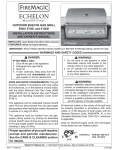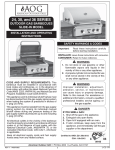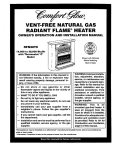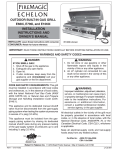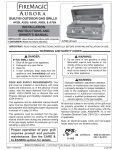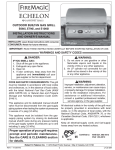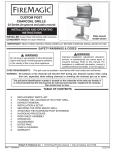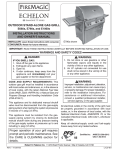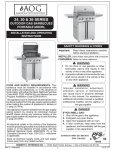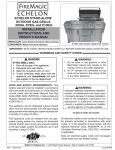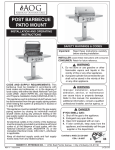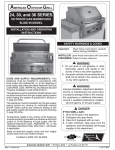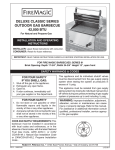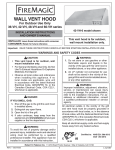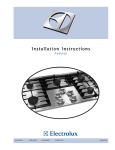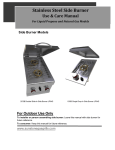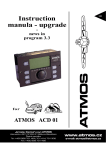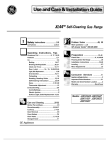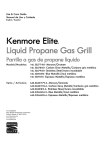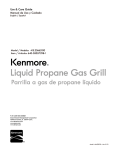Download AOG 3282 Series Operating instructions
Transcript
DOUBLE SIDEBURNER 3282 Series INSTALLATION AND OPERATING INSTRUCTIONS INSTALLER: Leave these instructions with consumer. CONSUMER: Retain for future reference. Important: READ THESE INSTRUCTIONS CAREFULLY BEFORE STARTING INSTALLATION SAFETY WARNINGS & CODES WARNING DANGER IF YOU SMELL GAS: 1. 2. 3. 4. 1. Do not store or use gasoline or other flammable vapors and liquids in the vicinity of this or any other appliance. 2. A propane cylinder not connected for use shall not be stored in the vicinity of this or any other appliance. Shut off the gas to the appliance. Extinguish any open flame. Open cover. If odor continues, keep away from the appliance, and immediately call your gas supplier or fire department. WARNING CODE AND SUPPLY REQUIREMENTS: This Improper installation, adjustment, alteration, appliance must be installed in accordance with local codes and ordinances, or, in the absence of local codes, with either the latest National Fuel Gas Code (ANSI Z223.1/NFPA 54), and Natural Gas and Propane Storage and Handling Installation Code (CSA-B149.1). This appliance and its individual shutoff valves must be disconnected from the gas supply piping system when testing the system at pressures in excess of ½ psig (3.5 kPa). This appliance must be isolated from the gas supply piping system by closing its individual manual shutoff valves during any pressure testing of the gas supply system at pressures up to and including ½ psig (3.5 kPa). Certified to: service, or maintenance can cause injury or property damage. Refer to this manual. For assistance or additional information consult a qualified professional installer, service agency, or the gas supplier. All electrical outlets in the vicinity of the appliance must be properly grounded in accordance with local codes or, in the absence of local codes, with the National Electrical Code, ANSI/NFPA 70, or the Canadian Electrical Code, CSA C22.1, whichever is applicable. Keep all electrical supply cords and fuel supply hoses away from any heated surface. ANSI Z21.58b-2012 CSA 1.6b-2012 11-38 American Outdoor Grill • PO Box 4053 • La Puente, CA 91747 REV 2 - 1401030955 1 L-C2-356 SÛRETÉ ET CODES D’AVERTISSEMENT INSTALLATION INSTRUCTIONS ET MANUEL DU PROPRIÉTAIRE DANS LE CONTRE- DOUBLE SIDEBURNER DANGER: AVERTISSEMENT: SI VOUS SENTEZ LE GAZ : 1. C o u p e z l ’ a d m i s s i o n d e g a z d e I’appariel. 2. Éteindre toute flamme nue. 3. Ouvrir le couvercle. 4. Si l’odeur persiste, éloignez-vous de l’appareil et appelez immédiatement le fournisseur de gaz ou le service d’incendie. 1. Ne stockez pas ou n’employez pas l’essence ou d’autres vapeurs et liquides inflammables à proximité de ceci ou d’aucun autre appareil. 2. Un cylindre de propane non relié pour l’usage ne sera pas stocké à proximité de ceci ou d’aucun autre appareil. CONDITIONS DE CODE ET D’APPROVISIONNEMENT: Ce gril doit être installé selon des codes et des ordonnances locaux, ou, en l’absence des codes locaux, avec l’un ou l’autre le plus défunt Code national de gaz de carburant (norme ANSI Z223.1/NFPA 54), et Stockage de gaz naturel et de propane et manipulation du code d’installation (CSA-B149.1). AVERTISSEMENT: L’ i n s t a l l a t i o n i n ex a c t e, l ’ a j u s t e m e n t , le changement, le service, ou l’entretien peuvent causer des dommages ou des dégats matériels. Référez-vous à ce manuel. Pour l’aide ou l’information additionnelle, consultez un installateur professionnel qualifié, l’agence de service, ou le fournisseur de gaz. Cet appareil et ses différents robinets d’isolement doivent être démontés du gaz-fournissent le système sifflant en examinant le système aux pressions au-dessus du ½ psig (kPa 3.5). Cet appareil doit être isolé dans gaz-fournissent le système sifflant par fermeture que ses différents robinets d’isolement manuels pendant tous les essais sous pression du gazfournissent le système aux pressions jusques et y compris le ½ psig (kPa 3.5). Toutes les sorties électriques à proximité du gril doivent être correctement fondues selon des codes locaux, ou en l’absence de local code, avec le code électrique national, ANSI/NFPA 70, ou le code électrique canadien, CSA C22.1, celui qui est applicable. • Ce gril est pour ultilisation à l’extérieur seulement. Si l’appareil est entreposé à l’intérieur, enlever les bouteilles et les laisser à l’extérieur. • Ne pas ranger le gril immédiatement aprés l’avoir utilisé. le laisser refroidir avant de le déplacer ou de la ranger. Le non respect de cette mesure de sécurité pourrait entraîner un incendie causant des dommages à la propriété, des blessures ou la mort. Maintenez tout électrique-fournissent des cordes et carburantfournissent des tuyaux partis de n’importe quelle surface de chauffage. LA PRESSION APPROPRIÉE D’OFFRE DE GAZ. • Ne couvrez jamais la surface entière de cuisine ou de gril • Ne pas utiliser cet appareil sous une surface de gauffreuses ou de casseroles. La surchauffe se produira et les brûleurs ne seront pas très performants quand la chaleur combustible. de combustion est emprisonnée au-dessous de la surface à • Ne pas utiliser cet appareil sous un auvent. Le non respect cuire. de cette mesure de sécurité pourrait entraîner un incendie ou • Ne pulvérisez jamais l’eau sur une unité chaude de gaz, des blessures. comme ceci peut endommager des composants de porcelaine • Dégagement minimal entre les parois latérales et l’arriére ou de fer de fonte. de l’appareil et la construction combustible (45.7 cm à partir • Une fuite de GPL peut causer une incendie ou une des parois latérales et 45.7cm à partir de l’arriére). explosion si enflammée entraînant des blessures corporelles • Le régulareur de pression de gaz prévu avec cet appareil graves ou la mort. de cuisson à gaz pour l’extérieur doit être utilisé. Ce régulateur est réglé pour une pression de sortie de 5 pouces de colonne • Communiquez avec le fournisseur de GPL pour les de l’eau pour le gaz naturel, et 10 pouces pour le propane. réparations ou pour disposer de qules bouteille ou du GPL non utilisé. • LE RÉGULATEUR INCLUS D’APPAREILS EST ÉVALUÉ Certifié à la norme: ANSI Z21.58b-2012 POUR LE MAXIMUM DE 1/2 (LIVRES PAR POUCE CARRÉ). CSA 1.6b-2012 SI VOTRE OFFRE DE GAZ EST 1/2 PLUS GRAND QUE (LIVRES PAR POUCE CARRÉ), UN RÉGULATEUR ADDITIONNEL DOIT ÊTRE INSTALLÉ AVANT LE GRIL. VOIR INSTALLATEUR : Laissez ces instructions avec le consommateur. LA SECTION DE CONDITIONS D’OFFRE DE GAZ POUR CONSOMMATEUR : Maintenez pour la future référence. REV 2 - 1401030955 2 L-C2-356 DOUBLE SIDEBURNER PARTS LIST Item 1. 2. or 3. 4. 5. 6. 7. 8. Part No. 3281-07 3529-S 3529 3279-32 3283-22 3016 23283-05 PR-4 3199-48 Description Stainless steel cover Grid, stainless steel Grid, porcelain cast iron Burner assembly (2) Valve manifold assembly Control knob (2) Control panel, stainless steel Regulator Igniter Assembly 1 3 2 4 6 8 7 8 PRODUCT DATA TABLE Specification Counter Opening Height Counter Opening Width* Counter Opening Depth Double Side Burner BTU per burner Natural Gas Orifice Propane Gas Orifice Value 81/2" 111/2" 22 3/4" 12,500 #53 #59 * When installing in combustible framing, a width of 12" is required to allow for proper airspace. See the next page for details. Table 1 - Product data table REV 2 - 1401030955 3 L-C2-356 PREPARING FOR INSTALLATION WHERE TO INSTALL YOUR DOUBLE SIDEBURNER Important: FOR OUTDOOR USE ONLY. Your double sideburner is designed to complement your grill. It provides a convenient, efficient cooking surface for side dishes that require bottom heat only. TOOLS REQUIRED The double sideburner has been pre-assembled. You need only a pair of wrenches, pliers, or vice grips for the gas connection. Do not install this unit under unprotected flammable surfaces. Do not install or use this appliance inside a building, garage, or any other covered area. It must not be used in or on recreational vehicles or boats. CODE AND SUPPLY REQUIREMENTS This burner must be installed in accordance with local codes and ordinances, or, in the absence of local codes, with the National Fuel Gas Code, ANSI Z223.1. This is a built-in type unit designed to fit into openfront enclosures. The control panel of the unit is removable for gas hookup, servicing, and burner adjustment. The control panel must be removable after you install the unit. This appliance and its individual shutoff valve must be disconnected from the gas supply piping system when testing the system at pressures in excess of 1/2 psig (3.5 kpa). INSTALLER NOTE: This unit should be installed so that it can be removed at a later date if factory service is required. Any protrusion into the double sideburner enclosure may prevent the unit from sliding into place (see GAS SUPPLY PLUMBING REQUIREMENTS, on page 5). The appliance must be isolated from the gas supply piping system by closing its individual manual shutoff valve during any pressure testing of the gas supply system at pressures up to and including 1/2 psig (3.5 kpa). ENSURING PROPER COMBUSTION AIR AND COOLING AIR FLOW ELECTRICAL OUTLETS Electrical outlets in the vicinity of this appliance must be properly grounded and GFCI equipped. Fig. 4-1 Top View 2 1/4" Hanger Min. 1/2" Max. 3/4" air gap to all combustible material* T h i s u n i t m ay b e i n s t a l l e d i n t o combustible framing (wood, for instance) provided there is a minimum of a 1/2" airspace between the sides of the unit and any combustible material. The unit is equipped with tabs on the sides and rear panels to assist in maintaining this 1/2" airspace. Use pliers to bend them outward as needed. This hanger requires 11/2" of countertop on each side and back to support the unit. You must maintain proper air flow for your double sideburner to perform as it was designed. If airflow is blocked, overheating and poor combustion will result. Make sure not to block the 1" front air inlet along the bottom of the control panel or more than 75% of the support grid surface with pans or griddles. Stainless steel hanger Fig. 4-2 Front View 2 Hanger 1/ 4" Counter Sideburner Edge of counter cut-out Countertop Sideburner Maintain air gap all the way down (back and side) under countertop *Use tabs on side and rear of unit to assist in this clearance. REV 2 - 1401030955 Counter 4 L-C2-356 PREPARING FOR INSTALLATION (Cont.) A REGULATOR MUST BE PROVIDED AT THE The gas supply pipe connection is to be made BOTTLE OR GAS SOURCE FOR USE WITH through the floor at the rear of the enclosure. PROPANE GAS. Install the gas line stub at least 2" away from the side walls and 1" from the back wall, but within 5" 22 23 3/4" 3/4" of the back wall, as illustrated by the shaded area 1" X in Fig. 5-1. GAS SUPPLY PLUMBING REQUIREMENTS: CAUTION: An external valve (with a removable key) in the gas line is advised for safety and convenience, particularly if the unit is accessible to children. 4" 2" GAS SUPPLY AND MANIFOLD PRESSURES: For natural gas - normal 7" water column (w.c.), minimum 3-1/2", maximum 10-1/2". For propane gas - normal 11" w.c., minimum 8", maximum 13". X 8 12" 1/2" HEIGHT Height 2" 11 1/2" 12 3/8" Width* WIDTH Fig. 5-1 *12" width when installed in combustible framing INSTALLATION 1. CHECKING FUEL AND PROPER ORIFICES c. Reach up under the burner support and AOG units are equipped with orifices for natural remove the burner retaining clip (see Fig. gas, unless otherwise indicated. For use with 5-1), located at the rear of the burner pipe. propane gas, smaller orifices must be installed d. Remove the burner cap and carefully lift to avoid hazardous overheating. Please refer the burner up and out, clearing the ceramic to Table 1 for the correct orifice size. Check electrode (see Fig. 5-2), and pulling the the orifice size by following the instructions burner tube away from the orifice, located below. The drill size is stamped on the orifice. on the end of the orifice holder on the left If the number is not visible you may have to side of the unit (see Fig. 5-3). remove the orifice (as detailed below) to read the number stamped on the side of the orifice. Note: You do not have to lift the burner completely out of the unit to access the IF YOU ARE NOT SURE YOU HAVE THE orifice. CORRECT SIDEBURNER ORIFICE SIZE (OR WISH TO CHANGE THE ORIFICE), FOLLOW THE e. Using a 3/8" socket, remove orifice from the STEPS BELOW. orifice holder (see Fig. 5-3) and check the number stamped on the orifice face. CAUTION: If the burner has been in use, wait until the burner and its components are cool to the touch. a. Remove sideburner cover and lift off cooking grid. b. Remove the control knobs and the screws found on each side of the control panel. Then carefully lift away the control panel. Note: Carefully, lift the control panel away from the frame. The spark generator for the ignition system is attached to the inside of the control panel. The spark generator knob need not be detached, but the wires must be unplugged from the generator before the face is completely removed. REV 2 - 1401030955 Fig. 5-1 Fig. 5-2 Orifice located at end of orifice holder Orifice holder Fig. 5-3 5 L-C2-356 INSTALLATION (Cont.) f. If an orifice change is necessary, replace the orifice with the correct sized one. e. Close the dedicated gas-supply shut-off valve, then slide the grill into place. Do not to pinch, kink, or damage the gas connector line. g. Replace the sideburner tube over the orifice, aligning the burner over the electrode, taking care not to detach it from the wire. h. Replace the burner retaining clip (underneath Note: Each side of the unit has a tab just behind the control panel. These tabs burner), and burner cap. prevent the control panel from moving i. Repeat steps c. through h. for the second inward. If the tabs interfere with the burner, then replace the grid and cover. unit sliding in (see Fig. 6-1), use pliers j. Replace the control panel, being sure to bend them inward so that they clear to reconnect the spark generator wires. the enclosure sides. Leave the tabs Replace the control knobs. slightly out to ensure they still keep the control panel from moving inward 2. CONNECTING THE GAS SUPPLY (see Fig. 6-2). THE SUPPLIED REGULATOR MUST BE REMOTELY ATTACHED IN-LINE BETWEEN THE GAS SUPPLY AND THE UNIT. Always ensure the orifices and regulator are set for the gas type your unit is to be installed to. a. Connect a C.S.A. listed 1/2" flex connector (not included) to the adapter found on the manifold. b. Install a 1/2" flare - 1/2" NPT adapter to the Fig. 6-1 Tab may interfere when flex connector. Then connect the supplied sliding in unit regulator to the adapter using pipe joint compound resistant to all gasses. Orient so that the arrow stamped on the regulator points in the direction of the gas flow. c. Run the gas supply pipe and install to the regulator. Use pipe joint compound resistant to all gasses. Ensure connections are tight. (An adapter is required if the gas supply pipe is other than 1/2" in diameter.) Fig. 6-2 Tab slightly bent in for clearance d. Turn all burner control knobs to the OFF position. Turn the gas supply on. Then carefully check all gas connections for Note: Additional tabs are provided on the leaks with a brush and half-soap/half-water side and rear panels and are only solution before lighting. Never use a match needed when installing in combustible or open flame to test for leaks. framing. See pg. 4 for details. 3. POSITIONING THE BURNER CAP Fig. 6-4 Place the burner cap so it is centered over the burner. Ensure that it rests securely in place. (Side burner) Adapter 6" Grill clearance Regulator Gas supply Flex connector REV 2 - 1401030955 6 L-C2-356 AIR SHUTTER ADJUSTMENT Air shutters are preset at the factory based on the gas the sideburner is built to burn. However, altitude or other local conditions may require air shutter adjustment for proper combustion. 4. Loosen the front burner air shutter adjustment screw, then use the tip of a screwdriver to open or close the air shutter until the flames appear blue and touch the burner ports. The flames from a properly adjusted sideburner will touch the burner ports and appear mostly blue. 5. Retighten the adjustment screw. 6. Repeat for rear burner air shutter. If they are orange, “lazy,” or lift off the burner ports, then adjust the sideburner air shutter using the following steps. Should you have difficulty accessing the rear burner air shutter, you may shut down, remove the rear burner (when cool), then adjust the air shutter to the same opening as the already adjusted front burner. (See INSTALLATION section to remove rear burner.) Be sure to properly reinstall rear burner when complete. The air shutters are located at the end of the burner assemblies, behind the control panel. They can safely and easily be adjusted while the unit is lit. CAUTION: Do not touch the sidebur ner surrounding top area, as it will be hot while adjusting the air shutter. 7. Once all adjustments are complete; be sure the unit is off and remove the knobs, then replace the control panel, being sure to reconnect the battery holder assembly wires. Replace the control knobs. 1. Remove the control knobs and screws first, then carefully lift away the control panel. Important: Prior to fully removing the control panel, you must disconnect the battery holder assembly wires that are located behind the control panel. 2. Replace the control knobs back on to the valve stems. Close Open 3. Light the sideburner following the LIGHTING INSTRUCTIONS section. Fig. 7-1 Fig. 7-2 SAFETY TIPS Each time you use your double sideburner, ensure that: 1. The area around the unit is clear and free from gasoline and other flammable vapors, liquids, and materials. 2. There is no blockage of air flow around the burner. 3. When using propane gas: a. The special ventilation openings in the enclosure are kept free and clear of debris. b. If connected to a propane cylinder, the rubber hose attached to the regulator is carefully inspected before each use. c. The propane cylinder, regulator, and rubber hose are installed in a location not subject to heating above 125° F (51° C). 4. Burner flames are burning evenly around the burner cap with a steady flame (mostly blue). A proper flame pattern will ensure safe operation and optimal performance. See AIR SHUTTER ADJUSTMENT section. Do not operate the burner with the cover in place. The valve, igniter, and burner on your double sideburner have been pre-assembled and tested before shipping. We suggest you follow and practice these instructions for safe lighting of your double sideburner. REV 2 - 1401030955 7 L-C2-356 NOTES PAGE Please use this page to record any information about your unit that you may want to have at hand. 8 LIGHTING (IGNITION) INSTRUCTIONS Read all instructions before lighting, and follow these instructions each time you light the unit. ELECTRONIC LIGHTING MANUAL LIGHTING Note: Electronic lighting requires an installed 9-volt battery with a good charge. CAUTION: Always wait five (5) minutes for gas to clear after any unsuccessful lighting attempt. 1. Open lid(s) or remove cover(s) from burner(s) to be lit. 2. Turn all gas control knob(s) to their OFF position(s). 2. Insert either either a burning burning long-barrel long-barrel butane butane lighter lighter,ora a burninglong-stem long-stemmatch, match or through the cooking grid burning a burning match held opening the top holder of the through lighting tube. (Fig. 9-2). by a wireto extension the cooking grid F o r b atoc kthe b uburner r n e r s(Fig. , ho l d Hold t h e the f l aflame me opening 9-2). a g a i n sthe t t hedge e su o f t h e b a ck bu r n e r. against ofr fa thec e burner. For sideburners, hold the flame against the burner. 3. While holding the match or lighter flame next to the holding the match or flame atatthe top of 3. While the match orlighter lighter flame the top burner, depress the control knob and while pressing the lighting tube or next to the burner (backburner of the lighting tube or next to the burner (sideburner turn it counterclockwise HI LIGHT position. only), depress the desired control knob and while and backburner only), depress thethe desired control Remove the lighter or match when burner lights, pressing turn it counterclockwise to the HI LIGHT knob and while turn it counterclockwise to and release thepressing control knob. position. Remove the Remove lighter or the the HI LIGHT position. thematch lighterwhen or match 4. If the burner does not light, immediately depress burnerthe lights, and release the control when burner lights, and releaseknob. the control the knob and turn the valve to OFF. WAIT FIVE knob. (5) MINUTES before repeating steps 2 through 4 4. Ifofthe doesLIGHTING not light, immediately theburner MANUAL instructions. depress the knob and turn the valve to OFF. WAIT FIVE (5) MINUTES before repeating steps 2 through 4 of the MANUAL LIGHTING instructions. 3. Turn on the gas at its source. Read Readsetting setting here (OFF position shown) here o TTO TTu OFF ONON rnRN TuTU ToT O F FFF OO Nn R r U HI LIGHT Press knob in to turn Note: DO NOT turn on more than one valve at a time for either electronic or manual lighting. HIGH to Use LIGHT HI (high) to light LOW Fig. 9-1 - Control knob 4. Depress the desired control knob for 5 seconds, then, while pressing turn it counterclockwise to the HI LIGHT position. Once the burner lights, release the knob. CAUTION: 1. Follow steps 1 through 3 (left). If a burner does not light within five (5) seconds of turning on the control knob, depress the knob and turn it to the OFF position. WAIT FIVE (5) MINUTES before repeating step 4. If you smell gas, follow the instructions on the cover of this manual. If the burners still do not light after several attempts, refer to the instructions for manual lighting. Lighting tube Lighter Fig. Fig.9-2 9-2 --Manual Manuallighting lighting 5. Repeat step 4 for each additional burner to be lit. SHUTTING OFF THE UNIT To shut off the unit, depress each valve control knob and, and while pressing turn it clockwise to the OFF position. Always close the valve from the gas supply after each use of the unit. WHEN USING A PORTABLE PROPANE TANK Propane tanks are equipped with a safety shutdown device that may cause low or no gas pressure/flame at the burners if operating and lighting instructions are not followed exactly (See important note in the TROUBLESHOOTING section for more details.) 9 ALLUMAGE DES INSTRUCTIONS (D’ALLUMAGE) Lisez toutes les instructions avant l’allumage, et suivez ces instructions chaque fois vous lumière le unité. ÉCLAIRAGE ÉLECTRONIQUE Note: ÉCLAIRAGE MANUEL L’éclairage électronique exige une batterie installée de 9 volts avec une bonne charge. RRN O SUTU TO ATTENTION: Attendez toujours cinq (5) minutes le gaz pour se dégager après que n’importe quelle 1. Ouvrez les couvercles ou enlevez les couvertures des brûleurs tentative non réussie d’éclairage. pour être Lit. 1. Suivez les étapes 1 à 3 (à gauche). 2. Tournez tous les boutons de commande de gaz à leurs Insérez un allumeur 2. Passez allumeur brûlant brûlant de debutane butanede delong-baril, long-baril une ou positions de repos. allumette brûlante de long-tige, ou une allumette une allumette brûlante de long-tige dans la grillebrûlante à cuire 3. Allumez le gaz à sa source. tenue parau undessus support prolongation fil par la Pour grille s’ouvrant dude tube d’éclairage.de (Fig. 10-2). à cuire s’ouvrant au brûleur (fi g. 10-2). Tenez la fl amme des backburners, tenez la fl amme contre le surface du Note: N’ouvrez LisezRead l’établissement ici setting (OUTRE de montrer) here contre le bord dudes brûleur. backburner. Pour sideburners, tenez la flamme contre pas plus d’une le brûleur. va l ve à l a fo i s FFE 3. Tout en tenant l’allumette ou la flamme plus légère à côté OD NE R R pour l’éclairage OFF U du brûleur, diminuez le bouton et légère tout en 3. Tout en tenant l’allumette ou la flamme l’allumette ou de la commande flamme plus plus légère UT T O électronique ou TO pressant le du tourtube il dans le sens ou contraire au dessus d’éclairage du brûleur d’éclairage ou àà côté côtédes du aiguilles brûleur manuel. d’une montreseulement), la position LÉGÈRE dediminuez HI. (sideburner etdans backburner seulement), le (backburner diminuez le bouton etEnlevez tout en HIGH to Utilisation LIGHT SALUT l’allumeur outour assortissez quand le brûleur s’allume, et bouton et le tout en de pressant le tourdésirés de commande désirés pressant commande il dans le sens (haute) Enfoncez libérez le bouton de commande. il dans le sens contraire des aiguilles d’une montre contraire des aiguilles d’une montre dans la position à la lule bouton mière pour dans la position LÉGÈRE de HI. Enlevez l’allumeur ou LÉGÈRE de ne HI.s’allume Enlevez l’allumeur ou assortissez quand 4. Si le brûleur pas, enfoncez immédiatement tourner assortissez quand leetbrûleur s’allume, et libérez le bouton le brûleur s’allume, libérez le bouton de commande. le bouton et tournez la valve à AU LOIN. ATTENDEZ Fig. 10-1 - bouton de commande de commande. CINQ (5) MINUTES avant de répéter les étapes 2 à 4 des manuelles d’éclairage. le instructions brûleur ne s’allume pas, enfoncez immédiatement 4. Diminuez le bouton de commande désiré pendant 5 4. Si le bouton et tournez la valve à AU LOIN. ATTENDEZ secondes, puis, et tout en pressant le tour il dans le sens CINQ (5) MINUTES avant de répéter les étapes 2 à 4 contraire des aiguilles d’une montre dans la position des instructions manuelles d’éclairage. LÉGÈRE de HI. Une fois que le brûleur s’allume, libérez le bouton. N HI LIGHT LOW ATTENTION : Si un brûleur ne s’allume pas dans cinq (5) secondes d’allumer le bouton de commande, enfoncez le bouton et tournezle à la position de repos. ATTENDEZ CINQ (5) MINUTES avant de répéter l’étape 4. Si vous sentez le gaz, suivez les instructions sur la couverture de ce manuel. Si les brûleurs ne s’allument toujours pas après que plusieurs tentatives, se rapportent aux instructions pour l’éclairage manuel. Tube d’éclairage Plus léger 5. Répétez l’étape 4 pour que chaque brûleur additionnel soit Lit. Fig. Fig.10-2 10-2 --Éclairage Éclairagemanuel manuel ARRÊT DU UNITÉ Pour couper le unité, diminuez chaque bouton de commande de valve et, et tout en pressant tour il dans le sens des aiguilles d’une montre à la position de repos. Fermez toujours la valve de la fourniture de gaz après chaque utilisation du unité. EN EMPLOYANT UN RÉSERVOIR DE PROPANE PORTATIF Des réservoirs de propane sont équipés d’un dispositif d’arrêt de sûreté qui peut ne pas causer le bas ou aucunes pression de gaz/flamme aux brûleurs si le fonctionnement et l’allumage des instructions ne sont pas suivis exactement (voir la note importante dans la section de dépannage pour plus de détails.) 10 SAFE USE & MAINTENANCE OF PROPANE GAS CYLINDERS IMPORTANT FOR YOUR SAFETY READ AND FOLLOW ALL WARNINGS PROVIDED WITH THE PROPANE-GAS CYLINDER. When operating this appliance with a propane-gas cylinder, these instructions and warnings MUST be observed. FAILURE TO DO SO MAY RESULT IN A SERIOUS FIRE OR EXPLOSION. CYLINDER/CONNECTOR REQUIREMENTS a. Propane-gas cylinders, valves, and hoses must be maintained in good condition and must be replaced if there is visible damage to either the cylinder or valve. If the hose is cut or shows excessive abrasion or wear, it must be replaced before using the gas appliance (see e.). The use of pliers or a wrench should not be necessary. Only cylinders marked “propane” may be used. To disconnect: Turn the hand nut counterclockwise until detached (Fig. 11-1). Important: Before using the unit, and after each time the cylinder is removed and reattached, check the hose for wear (see a.) and check all connections for leaks. Turn off the unit valves and open the main cylinder valve, then check connections with soapy water. Repair any leaks before lighting the unit. CAUTION: Always turn the propane cylinder main valve off after each use, and before moving the unit and cylinder or disconnecting the coupling. This valve must remain closed and the cylinder disconnected while the appliance is not in use, even though the gas flow is stopped by a safety feature when the coupler is disconnected. b. This unit, when used with a cylinder, should be connected to a standard 5-gallon (20 lb.) propane-gas cylinder equipped with an OPD (Overfill Prevention Device). The OPD has been required on all cylinders sold since October 1,1998, to prevent overfilling. c. Cylinder dimensions should be approximately 12" (30.5 cm) in diameter and 18" (45.7 cm) high. Cylinders must be constructed and marked in accordance with the Specifications for Propane Gas Cylinders of the U.S. Department of Transportation (D.O.T.) or the National Standard of Canada, CAN/CSA-B339, Cylinders, Spheres, and Tubes for Transportation of Dangerous Goods. d. The cylinder used must include a collar to protect the cylinder valve, and the cylinder supply system must be arranged for vapor withdrawal. e. The The pressure pressure regulator regulator and and hose hose assembly assembly (Fig. used 11-1) must match the specifi cation for Type I by ANSI Z 21.58-2005/ supplied with this outdoor gas appliance (L.P. models CGA must 1.6-2005 (see Fig. 11-1). only) be used. Original and replacement pressure regulator and hose assemblies must be those specified by the manufacturer for connection with a cylinder connecting device identified as Type I by the ANSI Z 21.58-2005/CGA 1.6-2005 (see PARTS LIST for ordering information). f. Carefully inspect the hose assembly each time before the gas is turned on. A cracked or frayed hose should be replaced immediately. If the appliance is stored indoors, the cylinder must be disconnected and removed. Disconnected cylinders must be stored outdoors, out of the reach of children, with threaded valve plugs tightly installed, and must not be stored in a building, garage, or any other enclosed area. FOR YOUR SAFETY The propane-gas cylinder valve must be equipped with a cylinder connection coupling device, described as Type I in the standard defined in paragraph e. above. This device is commonly described as an Acme thread quick coupler. g. If the propane-gas cylinder comes with a dust plug, place the dust cap on the cylinder valve outlet whenever the cylinder is not in use. QUICK COUPLER OPERATION To connect the regulator/hose assembly to the propanegas cylinder valve fitting: Press the hand nut on the regulator over the Acme thread fitting on the cylinder valve. Turn the hand nut clockwise to engage the threads and tighten until snug. a. DO NOT store a spare propane-gas cylinder under or near this appliance. b. NEVER fill the cylinder beyond 80-percent full. c. IF THE INFORMATION IN a. AND b. IS NOT FOLLOWED EXACTLY, A FIRE CAUSING DEATH OR SERIOUS INJURY MAY OCCUR. Fig. 11-1 Type I Acme thread quick coupler QCC Type 1 valve Pressure relief valve Hand wheel Brass Acme thread fitting Regulator UL Liquid level indicator (optional) Hand nut with Acme thread Vent Hose ENCLOSURE REQUIREMENTS FOR YOUR SAFETY, you must provide the openings listed below for drainage, replacement air, and cross-ventilation of any storage area exposed to possible leakage from gas connections, the unit, or propane cylinders. One side of the enclosure can be left completely open to the outside, OR 4 ventilation openings must be created: Two of the openings are to be at the cylinder valve level (approx. 16” above the floor) and on opposite walls of the enclosure. 2 more openings must be at the floor level (approx. 5” above the floor) and on opposite sides of the enclosure. Each opening must have a minimum of 10 sq. in. of free area. To achieve the proper ventilation, you may drill a series of holes, omit the grout from masonry joints, or replace a brick with a hardware cloth screen. If the floor in the cabinet is raised and the space beneath the cabinet is open to the outside, the lower ventilation openings may be in the floor. Consult your gas supplier for ventilation and regulator requirements when connecting to a household propane supply. 11 UTILISATION SÛRE ET ENTRETIEN DES CYLINDRES DE GAZ DE PROPANE IMPORTANT POUR VOTRE SÛRETÉ LISEZ ET SUIVEZ TOUS LES AVERTISSEMENTS ÉQUIPÉS DE VOTRE CYLINDRE DE GAZ DE PROPANE. En actionnant cet appareil avec un cylindre de gaz de propane ON DOIT observer ces instructions et avertissements. LE MANQUE DE FAIRE AINSI PEUT AVOIR COMME CONSÉQUENCE UNE INCENDIE OU UNE EXPLOSION SÉRIEUSE. main dans le sens des aiguilles d’une montre pour engager les CYLINDRE ET CONDITIONS ET fils et pour serrer jusqu’à ce que douillettement. L’utilisation des CARACTÉRISTIQUES DE CONNECTEUR pinces ou de la clé ne devrait pas être nécessaire. Seulement a. Des cylindres et les valves de gaz de propane doivent être le propane marqué par cylindres doit être employé. maintenus en bon état et doivent être remplacés s’il y a Pour débrancher: Tournez l’écrou de main dans le sens des dommages évidents au cylindre ou à la valve. b. Ce gril, une fois utilisé avec un cylindre, devrait être relié à contraire des aiguilles d’une montre jusqu’à isolé (fig. 12-1). c. d. e. e. f. g. un gallon de la norme 5 (20lb.) cylindre de gaz de propane équipé d’un OPD (remplissez au-dessus du niveau le dispositif d’empêchement). L’OPD a été exigé sur tous les cylindres vendus depuis octobre 1.1998 pour empêcher le remplissage excessif. Les dimensions de cylindre devraient être approximativement 12"(30.5cm) de diamètre et 18" (45.7cm) hauts. Des cylindres doivent être construits et marqués selon les caractéristiques pour des cylindres de gaz de propane du département des ETATS-UNIS du transport (D.O.T.) ou le niveau national du Canada, du CAN/CSA-B339, des cylindres, des sphères et des tubes pour le transport des marchandises dangereuses. Le cylindre doit inclure un collier pour protéger la valve de cylindre et le circuit d’alimentation de cylindre doit être assuré le retrait de vapeur. Le du de régulateur deet pression et le flexible (Fig.utilisé 12-1) Le montage régulateur pression l’ensemble de tuyau fourni avec cet appareil au gaz en plein air (modèles au doivent assortir les spécifications pour le type I par ANSI propane seulement) doit être utilisé. Assemblées d'origine et Z 21.58-2005/CGA 1.6-2005 (voir la figue. 12-1). régulateur de pression et le tuyau de remplacement doivent être ceux spécifiés par le fabricant pour le raccordement d'un dispositif de cylindre de liaison identifiée comme de type I par le 21.58-2005/CGA ANSI Z 1.6 à 2005 (voir liste des pièces pour les informations de commande). La valve de cylindre de gaz de propane doit être équipée d’un dispositif d’accouplement de raccordement de cylindre, décrit comme type I dans la norme définie dans le e. de paragraphe ci-dessus. Ce dispositif est généralement décrit comme coupleur rapide de fil de point culminant. Si votre cylindre de gaz de propane vient avec une prise de la poussière, placez le bouchon anti-poussière sur la sortie de valve de cylindre toutes les fois que le cylindre n’est pas en service. Important: Avant d’employer le gril, et ensuite chaque fois que le cylindre est enlevé et rattaché, examinez tous les raccordements pour déceler les fuites. Arrêtez les valves de gril et ouvrez la valve principale de cylindre, puis vérifiez les raccordements avec de l’eau savonneux. Réparez toutes les fuites avant d’allumer le gril. ATTENTION: Tournez toujours la valve principale de cylindre de propane au loin après chaque utilisation, et avant de déplacer le gril et le cylindre, ou débrancher l’accouplement. Cette valve doit rester fermée et le cylindre a débranché alors que l’appareil n’est pas en service, quoique l’écoulement de gaz soit arrêté par un dispositif de sûreté quand le coupleur est débranché. Inspectez soigneusement l’ensemble de tuyau chaque fois avant que le gaz soit allumé. Un tuyau criqué ou frangé devrait être remplacé immédiatement. Si l'appareil est stocké à l'intérieur, le cylindre doit être disconnected et a enlevé. Des cylindres Disconnected doivent être stockés dehors, hors de la portée des enfants, avec les prises de valve filetées étroitement installées, et ne doivent pas être stockés dans un bâtiment, le garage, ou n'importe quel autre secteur inclus. POUR VOTRE SÛRETÉ OPÉRATION DE COUPLEUR RAPIDE a. Ne stockez pas un cylindre de gaz disponible de propane dessous ou ne vous approchez pas de cet appareil. b. Ne remplissez jamais cylindre au delà de 80 pour cent de plein. c. SI L’INFORMATION DANS “A” ET “B” N’EST PAS SUIVIE EXACTEMENT, UN FEU CAUSANT LA MORT OU DES DOMMAGES SÉRIEUX PEUT SE PRODUIRE. Fig. 12-1 type coupleur rapide de fil de point culminant d’I Volant de commande QCC Type 1 4 1 Ajustage de précision 3 en laiton de fil de point culminant Régulateur Valve Pour relier le regulator/hose à l’ajustage de précision de valve de cylindre de gaz de propane: Serrez l’écrou de main sur le régulateur au-dessus de l’ajustage de précision de fil de point culminant sur la valve de cylindre. Tournez l’écrou de Valve de décompression UL 2 Indicateur de niveau de liquide (facultatif) Écrou de main avec le fil de point culminant. Passage Tuyau CONDITIONS DE CLÔTURE POUR VOTRE SÉCURITÉ, vous devez fournir les ouvertures énumérées ci-dessous pour le drainage, l'air de remplacement, et une ventilation transversale d'une zone de stockage exposés à une fuite possible des raccordements de gaz, l'unité, ou de bouteilles de propane. Un côté de l'enceinte peut être complètement ouvert sur l'extérieur, ou 4 ouvertures de ventilation doivent être créés: Deux des ouvertures doivent être au niveau robinet de la bouteille (environ 16 "au-dessus du sol) et sur des parois opposées de l'enceinte. 2 ouvertures plus doit être au niveau du sol (env. 5 "au-dessus du sol) et sur les côtés opposés de l'enceinte. Chaque ouverture doit avoir un minimum de 10 pouces carrés de surface libre. Pour parvenir à la bonne ventilation, vous pouvez percer une série de trous, omettez le coulis de joints de maçonnerie, ou de remplacer une brique avec un écran de toile métallique. Si le plancher de l'armoire est soulevée et l'espace situé sous le caisson est ouvert vers l'extérieur, les ouvertures d'aération inférieures peuvent être dans le sol. Consultez votre fournisseur de gaz pour les besoins de ventilation et de régulateur lors de la connexion à une alimentation en propane des ménages. 12 CARE & CLEANING APPLIANCE MUST BE COMPLETELY COOL WHEN CLEANING. DO NOT SPRAY ANY CLEANER OR LIQUIDS ON THE APPLIANCE WHEN HOT. The appliance must be cleaned as often as once a month (depending on use) to prevent grease build-up and other food deposits. Wipe with grain INTERIOR THE BURNER PORTS AND CARRY-OVER PORTS/ SLOTS MUST BE KEPT CLEAN TO ENSURE PROPER IGNITION AND OPERATION. Fig. 13-1 - Wipe with grain Remove the burner (see orifice changing instructions) and clean the ports and slots as required. Also inspect and clean the burner inlet for insects and nests. A clogged burner can lead to a fire in the bottom of the appliance. PROTECTING YOUR APPLIANCE FROM THE The inside of the appliance may be cleaned periodically WEATHER with oven cleaner if desired. Follow the oven cleaner An optional cover will protect your appliance when not instructions for proper use. in use. (Allow to cool before covering.) Be careful not to get oven cleaner on the outside surface Please specify the model number and serial number of the appliance as it can permanently damage the finish. of your appliance when ordering a cover. EXTERIOR Stainless steel surfaces when exposed to temperatures produced by the grilling process will change color. The stainless steel will change color from silver to brown and blue. This can be removed by using stainless steel cleaner. Clean your appliance by first using grill cleaner to remove grease and dirt. Always wipe with the grain (See Fig. 13-1). Next, use stainless steel cleaner to restore the stainless steel color (Note: not for mirror finish). Finish by wiping your appliance down using polish wipes. To clean any mirror finish (if applicable), use a quality brand glass cleaner only, not any of the cleaners mentioned above. IMPORTANT IN THE EVENT OF A GREASE FIRE, IMMEDIATELY SHUT OFF THE MAIN GAS VALVE TO THE GRILL. KEEP THE LID OPEN AND ALLOW THE FIRE TO EXTINGUISH ITSELF. A THOROUGH INSPECTION BY A TRAINED SERVICE TECHNICIAN SHOULD BE CONDUCTED BEFORE FUTURE USE OF YOUR GRILL. THE SERVICE TECHNICIAN WILL CHECK THE SYSTEM FOR GAS LEAKS AND WILL CHECK If your appliance is installed in a seaside (salt air) or ALL ELECTRICAL WIRING FOR DAMAGE. ALL GAS poolside (chlorine) location, it will be more susceptible LEAKS AND WIRING MUST BE REPAIRED PRIOR to corrosion and must be maintained/cleaned more TO FUTURE USE. frequently. Do not store chemicals (such as chlorine or fertilizer) near your stainless steel appliance. Due to the nature of stainless steel, surface iron oxide deposits may appear. Do not be alarmed – these deposits are removable with stainless steel cleaner through prompt and periodic maintenance. If not attended to promptly, permanent pitting may occur. By following these recommendations, you will enjoy the beauty and convenience of your appliance for many years to come. 13 CHECKING AND CONVERTING GAS TYPE This unit comes from the factory configured for one type WARNING of gas, as marked on the label located behind the control HAZARDOUS OVERHEATING WILL OCCUR IF A panel, or on the interior of the unit’s enclosure. NATURAL-GAS ORIFICE IS USED WITH PROPANE Converting this unit to burn a different type of gas GAS. IF YOU ARE NOT SURE IF THE CORRECT requires a conversion kit (contact your dealer for ORIFICES ARE INSTALLED, OR IF AN ORIFICE details). The professional installer who converts this CHANGE IS NECESSARY, REFER TO THE FOLLOWING unit to burn a different gas must perform the following INSTRUCTIONS. functions: CAUTION: Make sure the unit is at a safe temperature and isolated from gas and electrical 1. Change brass gas orifices (included at original shipping) supplies before beginning the tasks on each burner to match the new gas type (see outlined below. PRODUCT DATA TABLE, Table 1). 2. Switch the convertible gas regulator to match the new gas type (see section below). 3. Plumb the unit as appropriate for the new gas supply. Note: The cooler the unit, the greater the tolerances between the stainless-steel parts, and therefore the easier to disassemble and reassemble parts of the unit. 4. Apply the label for the new gas (included at original shipping) over the old gas information found on your CAUTION: For your safety, exercise caution and use adequate hand protection (such as unit. gloves) when handling potentially sharp sheet-metal parts. CHECKING AND CONVERTING THE REGULATOR Regulator: note cap on top Note: Each end of the plastic converter is engraved with either the letters “NAT” or “L.P.” (propane) for the respective gasses. When the converter is in the cap and the cap is held uppermost, the letters seen indicate the gas that the regulator is set up for. To convert the regulator from one gas to another, follow steps 1-4. STEP 1: Unscrew and remove the cap from the regulator, extracting the converter. Read gas type here STEP 2: Remove the converter (the plastic stalk) by carefully pulling it away from the center of the cap (it will snap out of its seating). STEP 3: Turn the converter around and replace it carefully, into the center of the cap (it will snap into place). Check that you can read the type of gas the unit is set for. STEP 4: Replace the unit into the regulator and screw down until snug. WARNING THIS APPLIANCE REGULATOR IS RATED FOR 1/2 PSI MAXIMUM. IF YOUR GAS SUPPLY IS GREATER THAN 1/2 PSI, AN ADDITIONAL REGULATOR MUST BE INSTALLED TO REDUCE THE INPUT PRESSURE TO THE UNIT to 1/2 PSI OR LESS. SEE GAS-SUPPLY REQUIREMENTS SECTION FOR PROPER GAS-SUPPLY PRESSURE. 14 REPLACING THE IGNITOR BATTERY 1. Remove the ignitor cover by turning it counterclockwise. Note: If you have accidentally removed the rubber cap, follow the instructions below to replace it. Important: Do not attempt to pull or turn the rubber cap. WRONG!! 2. Remove batter y for replacement. The battery is reinstalled with the negative (-) end out. 3. After properly inserting the battery, replace the ignitor cover by turning the cap clockwise. 1. Pull the rubber cap and the inner plastic sleeve apart. 2. Carefully insert the rubber cap into the ignitor cover so it sits behind inner lip. 3. Tu r n t h e c a p over and slide the inner plastic sleeve into the cap. TROUBLESHOOTING If you have trouble with the unit, please use this list to identify the problem. By trying one or more of the solutions to the possible cause, you should be able to solve the problem. If this list does not cover your present problem, or if you have other technical difficulties with the unit, please contact your local dealer. PROBLEM Ignition system failure POSSIBLE CAUSE 1) Improper air shutter adjustment 1) Adjust air shutters. 2) Ignition wire disconnected 2) Replug wires into generator. 3) Low gas pressure 3) Have gas company check the operating pressure at the unit. 4) Dead battery 4) Replace battery. 1) Improper air shutter adjustment 1) Adjust air shutters. 2) Using propane orifice for natural gas 2) Change orifices. 3) Low gas pressure/flame (natural) 3) Have gas company check the operating pressure at the unit. 4) Low gas pressure/flame (propane) 4) Refill propane tank, or reset propane tank safety*: Shut off all valves (including propane tank) and follow lighting instructions exactly. 1) Burner ports partially blocked by debris 1) Remove burners and clean out ports. 2) Small spiders or insects in burner 2) Inspect burners for spider webs or other debris that may block gas flow. 1) Va l ve “ L o w ” s e t t i n g n e e d s adjustment 1) Light burner on HIGH, immediately turn to LOW setting. Remove knob from valve and using a small flat screwdriver, slowly turn the adjustment screw in the stem, a little at a time (30° to 45°), in either direction, until the flame is approximately 1/4” in height from burner ports. Insufficient heat Uneven heating Burner goes out on LOW Rotisserie noisy CORRECTION 1) Rotisserie out of balance 1)L) Adjust counterbalance. Note: *Propane tanks are equipped with a safety shutdown device that may cause low or no gas/flame at the burners if operating and lighting instructions are not followed exactly. If you suspect the propane tank safety shutoff is in effect, shut off all burner control valves and the propane tank valve. Then read and follow the LIGHTING INSTRUCTIONS exactly. Lighting instructions are located in the owner’s manual. If the problem persists, continue troubleshooting, or contact your local dealer or distributor for assistance. 15 WARRANTY AMERICAN OUTDOOR GRILL LIMITED WARRANTY American Outdoor Grill warrants your grill to be free from defects in material and workmanship. American Outdoor Grill stainless-steel burners are warranted for FIFTEEN (15) YEARS. All other American Outdoor Grill parts are warranted for TEN (10) YEARS. (Except as noted below.) American Outdoor Grill infrared burners and vaporizer panels are warranted for THREE (3) YEARS. American Outdoor Grill ignition systems (excluding batteries) and accesories (including sideburners, motors, and thermometers) are warranted for ONE (1) YEAR. A COPY OF YOUR SALES SLIP FOR PROOF OF PURCHASE IS REQUIRED This warranty applies to the original purchaser for products which are installed in the United States or Canada and which are operated and maintained as intended for single family residential usage. This warranty is valid only with proof of purchase, shall commence on the date of purchase, and shall terminate (both as to original and any replacement products) on the anniversary date of the original purchase of the product stated on the above schedules. This warranty covers defects in material and workmanship. This warranty does not cover parts which become defective as a result of negligence, misuse, use not in compliance with the Owner’s Manual/Installation Instructions, accidental damage, improper handling, improper storage, improper installation, lack of required routine maintenance (as specified in the Owner’s Manual/Installation Instructions), electrical damage, local gas impurities or failure to protect against combustibles. Product must be installed (and gas must be connected) as specified in the Owner’s Manual/Installation Instructions by a qualified professional installer. Modifications to products which are not specifically authorized will void this warranty. Accessories, parts, valves, remotes, etc. when used must be Peterson products or this warranty is void. Warrantied items will be repaired or replaced at Peterson’s sole discretion. This warranty does not apply to rust, corrosion, oxidation, or discoloration unless the affected part becomes inoperable. This warranty does not cover labor or labor related charges, except as provided by separate specific written programs from the Peterson Co. All repair work must be performed by a qualified professional service person and requires prior approval of Peterson. Peterson may require the defective product or part to be returned to the factory to determine the cause of failure. Peterson will pay freight charges if the product or part is determined to be defective. This warranty does not cover breakage in shipment from our (Independent) distributor to its customer if the damage is determined to have occurred during that shipment. This warranty specifically excludes liability for indirect, incidental, or consequential damages. Some states and provinces do not allow the exclusion or limitation of incidental or consequential damages, so the above exclusion may not apply to you. This warranty gives you specified legal rights, and you may have other rights that vary from state to state or province. For additional information regarding this warranty, or to place a warranty claim, contact the R. H. Peterson dealer where the product was purchased. TO REGISTER YOUR PRODUCT TO: AMERICANOUTDOORGRILL WWW.RHPETERSON.COM, .COM, TO REGISTER YOUR PRODUCT ONLINEONLINE GO TO:GO WWW. AND CLICK ON PRODUCT REGISTRATION. THANK YOU FOR YOUR PURCHASE. Quality Check Burner Orifices Nat. Date:_________________ L.P. Leak Test: ___________ Model#: ___________________ Main: ____ ____ Burn Test: ___________ Serial#: ___________________ Other: ____ ____ Gas Type: Nat. / L.P. Air Shutter: ___________________ Inspector: ___________________ American Outdoor Grill • 14724 Proctor Avenue • City of Industry, CA 91746 16
This document in other languages
- français: AOG 3282 Series
















